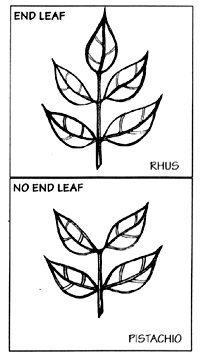The rhus tree (Toxicodendron succedaneum) is the most dangerous plant in Australia. It is classified as a noxious weed in New South Wales and South Australia and those growing the plant in these states can be fined up to $2000. If you live in other states and have a rhus tree in your garden, it is also advisable to get rid of it because it is a danger.
Many of the old gardening books state that only some people are allergic to the rhus plant but it has since been found that 98.5% of the population will develop an allergy of some kind after varying lengths of contact. Only 1.5% of the population will not develop an allergy to the rhus plant if they have contact with it over an extended period. Reactions vary from a rash to severe swellings of the limbs and face, sometimes producing temporary blindness.
It is possible to have a rhus tree in your garden without knowing it, as most come up as weeds and are spread by birds. The fruit is eaten by birds, often currawongs, and germinate in the bird’s droppings.
The name rhus is pronounced ‘rus’ (as ‘bus’) and the botanic name, Toxicodendron, means ‘poison tree’.
Identification
The rhus tree has a series of small leaflets on each leaf, ending in one V-shaped leaf. The leaves turn brilliant red in autumn and when fully grown, the tree reaches about 5m (16ft) tall. It has yellow flowers and large clusters of brown, cherry-sized berries which are not edible. The non-irritant pistachio tree (Pistacia chinensis) has similar leaves and is commonly mistaken for the rhus tree. It colours very well.
The two trees can be identified by the difference in their leaves. The rhus tree has an end leaf and the pistachio has no end leaf (See diagram).
Local councils can identify and advise if you have any problems.
Removing a rhus tree
It is best to get a professional tree surgeon to remove the tree for you. If this is not possible, here are some important things to remember when getting rid of a rhus tree:
Completely cover body with gloves, goggles and protective clothing.
Do not burn the tree to dispose of it, as the smoke could cause serious injury and possibly death.
Put all off-cuts into a strong garbage bag and take to the tip.
Note: Every part of the tree is poisonous.



